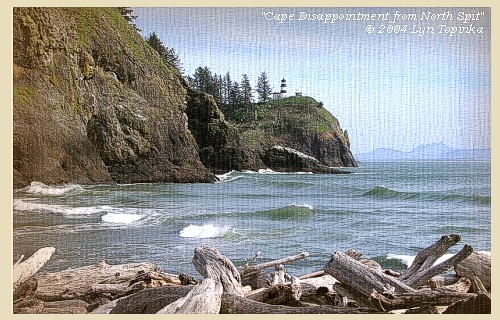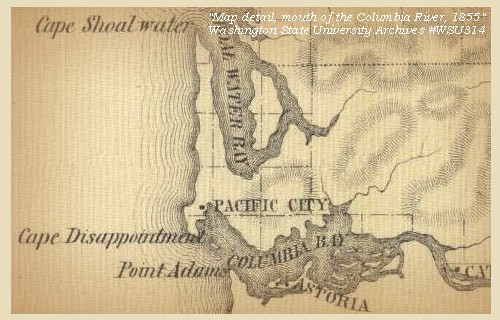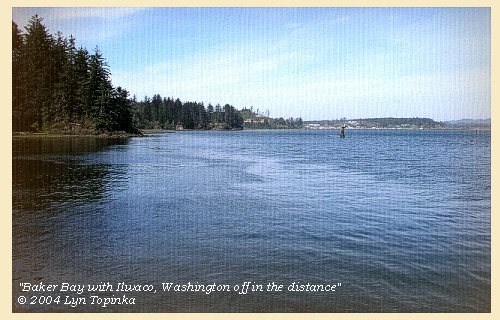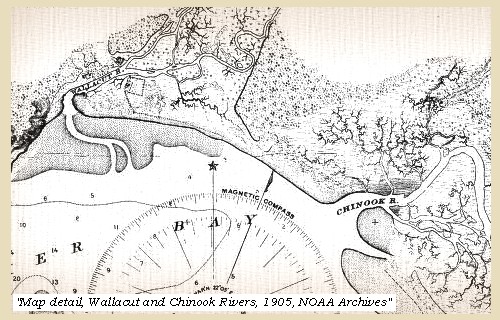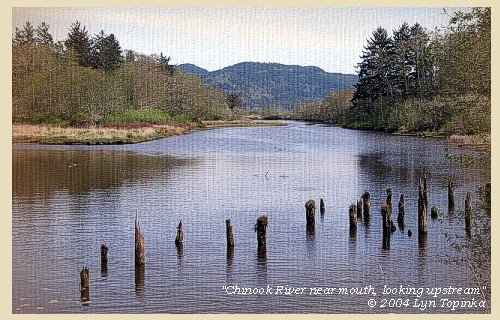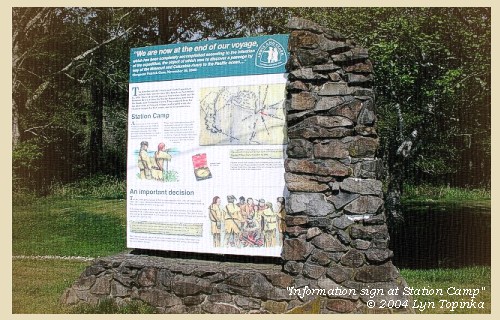The Volcanoes of
Lewis and Clark
Lewis and Clark
|
November 19 - 24, 1805 At the Pacific - Station Camp, Fort Canby, Long Beach |
|
Home
The Volcanoes of Lewis and Clark Map of the Journey Volcanoes, Basalt Plateaus, Major Rivers, etc. The Volcanoes Mount Adams, Mount Hood, Mount Jefferson, Mount Rainier, and Mount St. Helens CALENDAR of the Journey October 1805 to June 1806 Along the Journey Pacific Northwest Maps - Columbia River, Volcanoes, Flood Basalts, Missoula Floods, Geology, etc. The Corps of Discovery The Journey of Lewis and Clark About the Reference Materials The Journals, Biddle/Allen, DeVoto, Gass, Moulton, Topo Maps, and others USGS Lewis and Clark Links Links to USGS Websites highlighting the Lewis and Clark Journey Resources Publications Referenced and Websites Visited |
PREVIOUS
November 18 At the Pacific, Station Camp to Fort Canby |
November 19-24
At the Pacific, Station Camp, Fort Canby, Long Beach Station Camp, Cape Disappointment, North Head, McKenzie Head, Fort Canby, and the Lewis and Clark Interpretive Center, Long Beach Peninsula, Columbia River Beach Sands, Leadbetter Point, Baker Bay, Wallacut River, Chinook River, and Station Camp |
CONTINUE
November 25 Look for a Place to Winter, Station Camp to Pillar Rock |
|
To the Pacific - November 1805
At the Pacific - Station Camp, Fort Canby, Long Beach |
| On November 18, 1805, Captain Clark and 11 men began exploring the Cape Disappointment/Long Beach Peninsula area. They spent the night of November 18, 1805, camped on Cape Disappointment at the base of McKenzie Head. The main camp between November 15 through November 24, 1805, was "Station Camp", located near today's McGowan, Washington, today the site of Lewis & Clark Campsite State Park. |
| Tuesday, November 19, 1805 |
| In the night it began to rain, and continued till eleven o'clock [Captain Clark's camp on Cape Disappointment, at the base of McKenzie Head]. Two hunters were sent on to kill something for breakfast, and the rest of the party after drying their blankets soon followed. At three miles we overtook the hunters, and breakfasted on a small deer, which they had been fortunate enough to kill. ...... |
| "... began to rain a little before day and Continued raining untill 11 oClock I proceeded on thro emencely bad thickets & hills crossing 2 points to a 3rd on which we built a fire and Cooked a Deer ... from this point I can See into a Deep bend in the coast to the N.E. (N 40o E) for 10 miles. after Brackfast I proceeded on N. 20 E. 5 miles Comcement a large Sand bar at a low part ponds a little off from the Coast here the high rockey hills end and a low marshey Countrey Suckceed. ..." [Clark, November 19, 1805, first draft] |
| We then continued over rugged hills and steep hollows, near the sea, on a course about north 20? west, in a direct line from the cape [Cape Disappointment], till at the distance of five miles, we reached a point of high land, below which a sandy beach extends, in a direction north 10? west, [Long Beach Peninsula] to another high point about twenty miles distant. This eminence we distinguished by the name of point Lewis [Leadbetter Point]. |
| It is there that the highlands, which at the commencement of the sandy beach, recede towards Chinnook river, again approach the ocean. The intermediate country is low, with many small ponds, crowded with birds, and watered by the Chinnook [Willapa Bay, Willapa National Wildlife Refuge, and the Naselle River], on the borders of which resides the nation of the same name. We went four miles along the sandy beach to a small pine tree, on which captain Clarke marked his name, with the year and day, and then returned to the foot of the hills, passing on the shore a sturgeon ten feet long, and several joints of the back bone of a whale, both which seem to have been thrown ashore and foundered. After dining on the remains of the small deer, we crossed in a southeastern direction to the bay [Baker Bay], where we arrived at the distance of two miles, then continued along the bay, |
| crossed Chinnook river [Wallacut River], and encamped on its upper side, in a sandy bottom. |
|
|
|
The Main Camp - November 15 through November 24, 1805:
"Station Camp", near today's McGowan, Washington. Clark's Camp: Upstream of the Wallacut River. |
| Wednesday, November 20, 1805 |
| It rained in the course of the night. A hunter despatched early to kill some food, returned with eight ducks, on which we breakfasted, and then followed the course of the bay [Baker Bay] to the creek or outlet of the ponds [Chinook River]. It was now high tide, the stream three hundred yards wide, and no person in the cabin to take us across. We therefore made a small raft, on which one of the men passed and brought a canoe to carry us over. |
| As we went along the beach we were overtaken by several Indians, who gave us dried sturgeon and wappatoo roots, and soon met several parties of Chinnooks returning from the camp [Station Camp, near McGowan, Washington]. ...... |
|
|
|
The Camp - November 15 through November 24, 1805:
"Station Camp", near today's McGowan, Washington. |
| Thursday, November 21, 1805 |
| The morning was cloudy, and from noon till night it rained. The wind too was high from the southeast, and the sea so rough that the water reached our camp. ...... |
|
|
|
The Camp - November 15 through November 24, 1805:
"Station Camp", near today's McGowan, Washington. |
| Friday, November 22, 1805 |
| It rained during the whole night, and about daylight a tremendous gale of wind rose from the S.S.E. and continued during the whole day with great violence. The sea runs so high that the water comes into our camp, which the rain prevents us from leaving. ...... |
|
|
|
The Camp - November 15 through November 24, 1805:
"Station Camp", near today's McGowan, Washington. |
| Saturday, November 23, 1805 |
| The rain continued through the night, but the morning was calm and cloudy. The hunters were sent out and killed three deer, four brant, and three ducks. Towards evening seven Clatsops came over in a canoe with two skins of the sea-otter. To this article they attach an extravagant value, and their demands for it were so high that we were fearful of reducing our small stock of merchandise, on which we must depend for subsistence as we return, to venture on purchasing. ...... |
|
|
|
The Camp - November 15 through November 24, 1805:
"Station Camp", near today's McGowan, Washington. |
| Sunday, November 24, 1805 |
| The morning being fair, we dried our wet articles and sent out the hunters, but they returned with only a single brant. In the evening a chief and several men of the Chinnooks came to see us; we smoked with them, and bought a sea-otter skin for some blue beads. Having now examined the coast, it becomes necessary to decide on the spot for our wintering quarters. The people of the country subsist chiefly on dried fish and roots, but of these there does not seem to be a sufficient quantity for our support, even were we able to purchase, and the extravagant prices as well as our small store of merchandise forbid us to depend on that resource. We must therefore rely for subsistence on our arms, and be guided in the choice of our residence by the abundance of game which any particular spot may offer. The Indians say that the deer is most numerous at some distance above on the river, but that the country on the opposite side of the bay is better supplied with elk, an animal much larger and more easily killed than deer, with a skin better fitted for clothing, and the meat of which is more nutritive during the winter, when they are both poor. The climate too is obviously much milder here than above the first range of mountains, for the Indians are thinly clad, and say they have little snow; indeed since our arrival the weather has been very warm, and sometimes disagreeably so: and dressed as we are altogether in leather, the cold would be very unpleasant if not injurious. The neighbourhood of the sea is moreover recommended by the facility of supplying ourselves with salt, and the hope of meeting some of the trading vessels, who are expected in about three months, and from whom we may procure a fresh supply of trinkets for our route homewards. These considerations induced us to determine on visiting the opposite side of the bay, and if there was an appearance of much game to establish ourselves there during the winter. Next day, |
|
|
|
The Camp - November 15 through November 24, 1805:
"Station Camp", near today's McGowan, Washington. |
| Home | Previous | Continue |
If you have questions or comments please contact: GS-CVO-WEB@usgs.gov
June/July 2004, Lyn Topinka
The Volcanoes of Lewis and Clark Home Page | CVO Home Page


